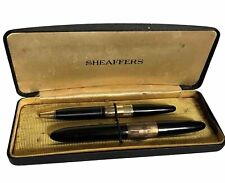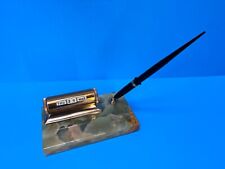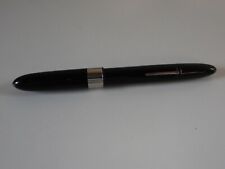When you click on links to various merchants on this site and make a purchase, this can result in this site earning a commission. Affiliate programs and affiliations include, but are not limited to, the eBay Partner Network.
VTG MODERN MARBLE TOP DESK SET ESTERBROOK PARKER PEN BLACK ONYX SEMCA 8 7 JEWEL Click to view supersize image
Click to view supersize image
GREETINGS, FEEL FREE
TO
\"SHOP NAKED.\"©
We deal in items we believe others will enjoy and want to purchase.
We are not experts.
We welcome any comments, questions, or concerns.
WE ARE TARGETING A GLOBAL MARKET PLACE.
Thanks in advance for your patronage.
Please Be sure to add WDG to your favorites list!
NOW FOR YOUR VIEWING PLEASURE…
SHEAFFER 2-75J + 584
BLACK MARBLE DESK SET
WITH CLOCK
(5) FIVEPIECE
MID CENTURY MODERN
OFFICE DECORSENCA \"8\" SEVEN JEWEL
SERIAL NUMBER 977839
SWISS MOVEMENT CLOCK
BRASS MOUNT
(AGED w SURFACE WEAR, SPRING IS TOO TIGHT, NEEDS WORK)
SANFORD 2oz
EMBOSSED \"276\" UNDERSIDE
GLASS INK JARESTER BROOK
BLADDER FOUNTAIN PEN
\"9668\" NIBPARKER PEN
JANESVILLE, WISCONSIN
PARKER \"21\"
SUPERCHROME14\" x 8\" x 1\"
BLACK MARBLE ONYX
RECESSED PEN HOLDER
2 UPRIGHT RESTS
BRONZENAME PLATE
(SCRATCHES ON SURFACE, CAN BE BUFFED OUT)
PIECE SHOWS AGE w/ WEAR
NO CRACKS OR CHIPS ON THE MARBLE.HOTEL ENTRY WAY
REGISTRY / FRONT DESKSTAND
BED & BREAKFAST WELCOME LOG
ELEGANT OFFICE DECOR
FYI
A fountain pen is a nib pen that, unlike its predecessor the dip pen, contains an internal reservoir of water-based liquid ink. The pen draws ink from the reservoir through a feed to the nib and deposits it on paper via a combination of gravity and capillary action.Filling the reservoir with ink may be achieved manually (via the use of a Pasteur pipette or syringe), or via an internal filling mechanism which creates suction (for example, through a piston mechanism) to transfer ink directly through the nib into the reservoir. Some pens employ removable reservoirs in the form of pre-filled ink cartridges. A fountain pen needs little or no pressure to write.History
The earliest historical record of a reservoir pen dates to the 10th century. In 953, Ma\'ad al-Mu\'izz, the caliph of the Maghreb, demanded a pen that would not stain his hands or clothes, and was provided with a pen that held ink in a reservoir and delivered it to the nib, which could be held upside-down without leaking, as recorded in Kitab al-Majalis wa \'l-musayardt, by Qadi al-Nu\'man al-Tamimi (d. 974). No details of the construction or mechanism of operation of this pen are known, and no examples have survived.In Deliciae Physico-Mathematicae (a 1636 magazine), German inventor Daniel Schwenter described a pen made from two quills. One quill served as a reservoir for ink inside the other quill. The ink was sealed inside the quill with cork. Ink was squeezed through a small hole to the writing point. Noted Maryland historian Hester Dorsey Richardson (1862–1933) documented a reference to \"three silver fountain pens, worth 15 shillings\" in England during the reign of Charles II, ca. 1649-1685. She also found a 1734 notation made by Robert Morris the elder in the ledger of the expenses of Robert Morris the younger, who was at the time in Philadelphia, for \"one fountain pen\".In 1828 Josiah Mason improved a cheap, efficient slip-in nib in Birmingham, England, which could be added to a fountain pen and in 1830, with the invention of a new machine, William Joseph Gillott, William Mitchell[disambiguation needed] and James Stephen Perry devised a way to mass manufacture robust, cheap steel pen nibs. This boosted the Birmingham pen trade and by the 1850s, more than half the steel-nib pens manufactured in the world were made in Birmingham. Thousands of skilled craftsmen and -women were employed in the industry. Many new manufacturing techniques were perfected, enabling the city\'s factories to mass produce their pens cheaply and efficiently. These were sold worldwide to many who previously could not afford to write, thus encouraging the development of education and literacy.Progress in developing a reliable pen was slow until the mid-19th century, because of an imperfect understanding of the role that air pressure plays in the operation of pens and because most inks were highly corrosive and full of sedimentary inclusions. The Romanian inventor Petrache Poenaru received a French patent for the invention of the first fountain pen with a replaceable ink cartridge on May 25, 1827. Starting in the 1850s there was a steadily accelerating stream of fountain pen patents and pens in production. However, it was only after three key inventions were in place that the fountain pen became a widely popular writing instrument. Those were the iridium-tipped gold nib, hard rubber, and free-flowing ink.The first fountain pens making use of all these key ingredients appeared in the 1850s. In the 1870s Duncan MacKinnon, a Canadian living in New York City, and Alonzo T. Cross of Providence, Rhode Island, created stylographic pens with a hollow, tubular nib and a wire acting as a valve. Stylographic pens are now used mostly for drafting and technical drawing but were very popular in the decade beginning in 1875. In the 1880s the era of the mass-produced fountain pen finally began. The dominant American producers in this pioneer era were Waterman, of New York City, and Wirt, based in Bloomsburg, Pennsylvania. Waterman soon outstripped Wirt, along with many companies that sprang up to fill the new and growing fountain pen market. Waterman remained the market leader until the early 1920s.At this time fountain pens were almost all filled by unscrewing a portion of the hollow barrel or holder and inserting the ink by means of an eyedropper—a slow and messy procedure. Pens also tended to leak inside their caps and at the joint where the barrel opened for filling. Now that the materials\' problems had been overcome and the flow of ink while writing had been regulated, the next problems to be solved were the creation of a simple, convenient self-filler and the problem of leakage. Self-fillers began to arrive around the turn of the century; the most successful of these was probably the Conklin crescent-filler, followed by A. A. Waterman\'s twist-filler. The tipping point, however, was the runaway success of Walter A. Sheaffer\'s lever-filler, introduced in 1912, paralleled by Parker\'s roughly contemporary button-filler.Meanwhile many inventors turned their attention to the problem of leakage. Some of the earliest solutions to this problem came in the form of a \"safety\" pen with a retractable point that allowed the ink reservoir to be corked like a bottle. The most successful of these came from F.C. Brown of the Caw\'s Pen and Ink Co. and from Morris W. Moore of Boston. In 1907 Waterman began marketing a safety pen of its own that soon became the most widely distributed such pen. For pens with nonretractable nibs, the adoption of screw-on caps with inner caps that sealed around the nib by bearing against the front of the section effectively solved the leakage problem (such pens were also marketed as \"safety pens\", as with the Parker Jack Knife Safety and the Swan Safety Screw-Cap).In Europe, the German supplies company which came to be known as Pelikan and was started in 1838, first introduced their pen in 1929, based upon the acquisition of patents for solid-ink fountain pens from the factory of Slavoljub Penkala from Croatia (patented 1907, in mass production since 1911), and the patent of the Hungarian Theodor Kovacs for the modern piston filler by 1925.The decades that followed saw many technological innovations in the manufacture of fountain pens. Celluloid gradually replaced hard rubber, which enabled production in a much wider range of colors and designs. At the same time, manufacturers experimented with new filling systems. The inter-war period saw the introduction of some of the most notable models, such as the Parker Duofold and Vacumatic, Sheaffer\'s Lifetime Balance series, and the Pelikan 100.During the 1940s and 1950s, fountain pens retained their dominance: early ballpoint pens were expensive, were prone to leaks and had irregular inkflow, while the fountain pen continued to benefit from the combination of mass production and craftsmanship. This period saw the launch of innovative models such as the Parker 51, the Sheaffer Snorkel and the Eversharp Skyline and (later) Skyliner, while the Esterbrook J series of lever-fill models with interchangeable steel nibs offered inexpensive reliability to the masses.By the 1960s, refinements in ballpoint pen production gradually ensured its dominance over the fountain pen for casual use. Although cartridge-filler fountain pens are still in common use in France, Germany, India and the United Kingdom, and are widely used by young students in most private schools in England and at least one private school in Scotland,[5] a few modern manufacturers (especially Montblanc and Visconti) now depict the fountain pen as a collectible item or a status symbol, rather than an everyday writing tool.Nibs
The modern fountain pen nib may be traced back to the original gold nib which had a tiny fragment of ruby attached to form the wear-point. Following the discovery of the Platinum group of metals which include ruthenium, palladium, osmium and iridium, a small quantity of iridium was isolated and used on the iridium-tipped gold dip pen nibs of the 1830s. Today, nibs are usually made of stainless steel or gold alloys, with the most popular gold content being 14 carat (58?%) and 18 carat (75%). Gold is considered the optimum metal for its flexibility and its resistance to corrosion, although gold\'s corrosion resistance is less of an issue than in the past because of better stainless steel alloys and less corrosive inks. Gold nibs are tipped with a hard, wear-resistant alloy that typically uses metals from the platinum group. The tipping material is often called \"iridium\", but there are few, if any, penmakers that still use tipping alloys containing the metal. Steel nibs may also have harder tips; those with un-tipped steel points will wear more rapidly due to abrasion by the paper.The nib usually has a slit cut down its centre, to convey the ink down the nib by capillary action, as well as a \"breather hole\" of varying shape to promote the exchange of air for ink in the pen\'s reservoir. The breather hole also acts as a stress relieving point, preventing the nib from cracking longitudinally from the end of the slit as a result of repeated flexing during use. The whole nib narrows to a point where the ink is transferred to the paper. Broad calligraphy pens may have several slits in the nib to increase ink flow and help distribute it evenly across the broad point. Nibs divided into three \'tines\' are commonly known as \'music\' nibs, as their line, which can be varied from broad to fine, is suited for writing musical scores. Although the most common nibs end in a round point of various sizes (fine, medium, broad), various other nib shapes are available. Examples of this are oblique, reverse oblique, stub, italic and 360 degree nibs. Flexibility in fountain pen nibs is determined in several ways. First, thickness of the nib is important. When the nib alloy has been pressed thick it will result in a hard nib, while thinly pressed nibs are more flexible. Also, should a nib be thinner at the feed and thicker at the tip flexibility is improved. Second, the curve of a nib determines in part how stiff the nib will be. Nibs pressed into more deeply convex curves, or into three or five faceted curves will be stiffer than flatter nibs. Third, the \"breather hole\" size, shape, and position alter the stiffness. Should a heart shaped hole be wider than normal it will imbue a flexibility to the nib, while round, small holes give made a nib stiff. Fourth, the length of the tines determines how far they may spread under pressure. With shorter tines a nib will be stiffer. Fifth, the alloy used can affect stiffness, steel is stiffer than gold alloys, and more pure gold (18k, 21k) is softer than diluted gold.
(THISPICTUREFOR DISPLAY ONLY)
Thanks for choosing this sale. You may email for alternate payment arrangements. We combine shipping. Please pay promptly after the sale. The item will be shipped upon receipt of funds. Remember if you are outside the continental US there will be additional shipping costs. Also, INTERNATIONAL CUSTOMS is the international buyers obligation and must be aware of their own customs laws. We cannot be responsible for seized or quarantine purchases. If your shipping costs seems high, it is because we ensure that your purchase is well packed, quickly delivered, and insured to arrive safe and sound. WE ARE GOING GREEN, SO WE DO SOMETIMES USE CLEAN RECYCLED MATERIALS TO SHIP. DO NOT BE TOO PERSNICKETY.
Please leave response when you have received the item and are satisfied. Please respond when you have received the item * If you were pleased with this transaction, please respond with all 5 stars! If you are not pleased, let us know via e-mail. Our goal is for 5-star service. We want you to be a satisfied, return customer.
Please express any concerns or questions. More pictures are available upon request. The winning offer will incur the cost of S/H INSURED FEDEX OR USPS. See rate calculator or email FOR ESTIMATE. International buyers are Welcome but be mindful if your country is excluded from safe shipping. Additional costs will be applied to postage outside the continental US.
Thanks for perusing THIS and ALL our sales.
Please Check out our other items!
WE like the curious and odd.
BUY, BYE!!
Pictures sell!
Auctiva Free Image Hosting.Show off your items with
Auctiva\'s Listing Templates
Auctiva,
THE simple solution for sellers.
Track Page Views With
Auctiva\'s FREE Counter
On Dec-12-16 at 14:12:34 PST, seller added the following information:









